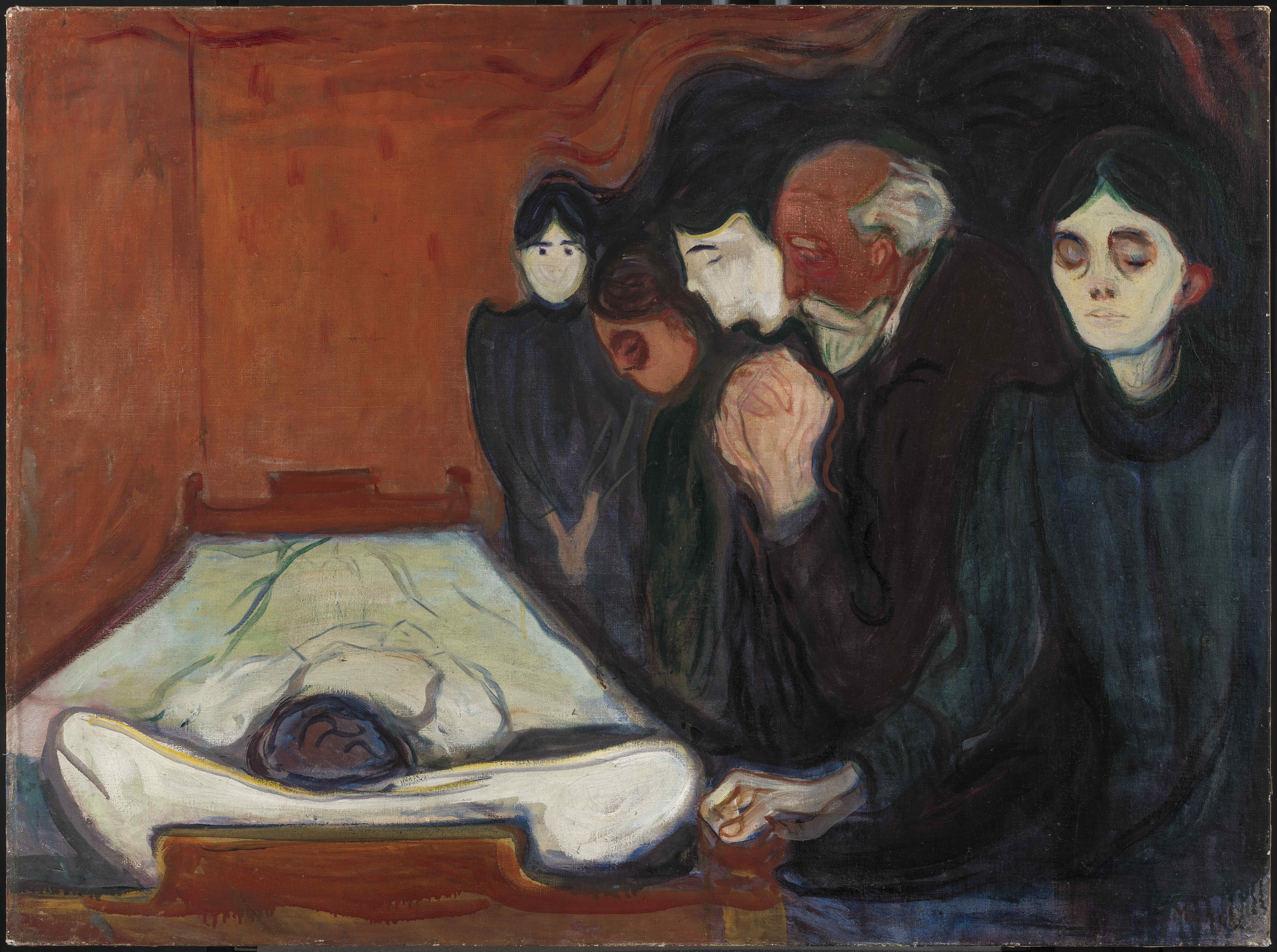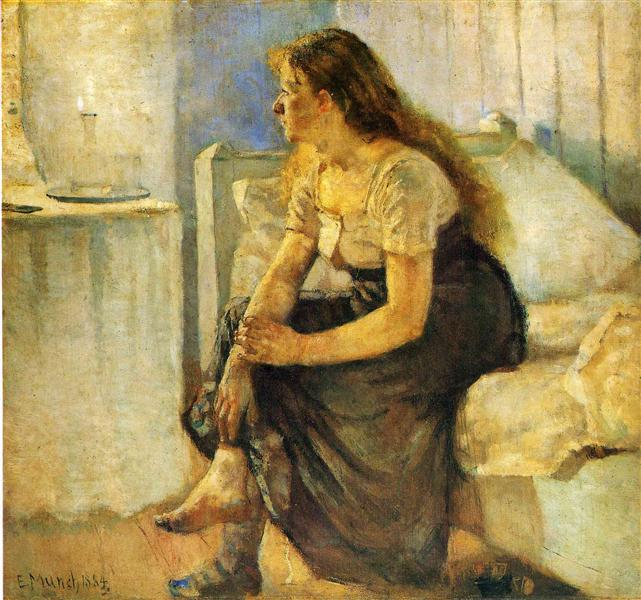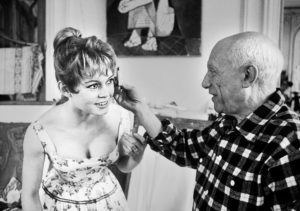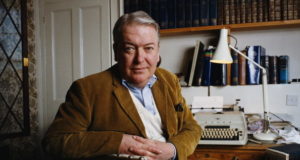The characters depicted in Edvard Munch’s paintings are rarely having a good time. Lamp-lit streets are thronged by haunted faces. Characters sit hunched over small tables in dim and dark bars, nursing glasses of wine, their gaze fixed on the middle distance. And then there is The Scream.
Even when, occasionally, the seductive femme fatale figures are expressing joy, it’s more schadenfreude than innocent pleasure. They delight in cavorting with a new lover while their ex paramour skulks miserably in the background. Or else they are resplendently basking in their own physical charms while a rejected man stands sadly nearby.
Unsurprisingly, then, the majority of the paintings featured in Edvard Munch: Masterpieces from Bergen — which opens at the Courtauld next month — are sad scenes. By the Deathbed (1896), for example, shows a family assembled round a prone female figure, their eye sockets deep with misery, their faces gaunt and their mouths agape with wordless grief.

There is a purpose to this misery. In 1932, Munch wrote: “In my art, I have tried to clarify life and its meaning for myself. I also intended to help others explain life for themselves”. Art, then, was used by him as a form of therapy: a way of making sense of sadness and helping others to heal. Confronting us with our own angst and sorrows, he has a knack for reaching out to viewers of every background, in every age. He understands the nuances of relationships — the petty jealousies, the spite — and they manifest in his characters, who appear to us, the viewers, as all too human.
One of the first paintings you see as you enter into the exhibition, which is currently on in Bergen, is Man and Woman (1898). Two figures are seated in a bedroom: a woman sits back on the bed, nude, while the man sits with his head in his hands, in apparent torment. It is clear that a conversation has taken place, one that has upset the man; the woman is seductive, very much in charge in the relationship dynamic.

Munch was born to a bourgeois family in Christiania, the son of a doctor. Although by some measures he had a relatively privileged childhood, grief was at his heels. Both his mother and sister succumbed to tuberculosis, the latter at only 15 years old. Munch himself nearly died of a pulmonary attack as a child: as he coughed up blood, his relatives feared the worst. He survived, but was left with chronic bronchitis, and a permanently altered perception of the world.
Munch reportedly suffered from depression and anxiety. The Scream bears the inscription: “Can only have been painted by a madman”. In 1905 the artist wrote, “You know my picture, The Scream […] nature was screaming in my blood — I was at breaking point”. And so he made art, as a form of expulsion. He once wrote that he tried to “paint out [his] fears”, in a way that a classical composer might throng their melodies with angst.
In Bergen, I had the opportunity to see behind the scenes of the exhibition, where several of Munch’s paintings were in the slow process of restoration. Apparently, he had a habit of keeping his finished paintings outdoors to see the effect the weather would have on the drying paint: he had put his canvases on the beach and in snowy gardens. One imagines his collectors furrowing their brows at such activities: surely Munch’s work needed better preservation and care than this? But as an artist he was very much invested in the present moment: he felt emotions intensely and wanted to act on his impulses.
Munch joined an avant-garde group of bohemian intellectuals in Oslo, in 1884, called the Christiania Boheme. They lived by a theory of creativity that maintained that the artist must look exclusively to his or her own feelings and thoughts in order to produce art of the highest order. Members of this group spurned middle class mores, supported sexual equality and free love, and advocated for intellectual freedom.
Around this time, Munch had an affair with a married woman, Milly Thalow, who was to be the (later unrequited) love of his life. He travelled across France, Norway and Denmark, learning from other painters, but his mental illness reared its head once more and led him to drink excessively: by 1908, Munch’s drinking had become uncontrollable, and he was hospitalised for long periods.
While sectioned in Norway, the hospital advocated for Munch to resume his drawing and painting as occupational therapy: it worked, in that it stopped the artist drinking, and he was able to resume his activities in the outside world. He had by this point, however, renounced his artistic goals. In 1909, he wrote that he no longer wished to paint “individual man’s sorrows and joys seen at close quarters, but rather the great eternal powers”. In his work after this point, there is a new expansiveness, a romanticism.
“What would you say was the archetypal Norwegian temperament?” I asked one of the exhibition managers. Smiling bashfully, he answered: “Shy. We are all shy. We used to all be farmers, you see.” Munch got around his shyness through painting: feelings he felt unable to express in person, he could scratch away onto canvas, their truth resplendent across centuries.

Did art cure him? Ultimately, Munch lived to the ripe old age of 81: his artistic pursuits all but cured his alcoholism, and tempered his melancholia.
As for the viewers, if we are not healed by viewing Munch’s works, we are at the very least consoled by seeing our innermost feelings so painstakingly laid out on canvas.
We might experience an uncanny sensation, like the one described by Munch, when he wrote of the married woman whose memory plagued him for decades:
“I felt as if there were invisible threads connecting us, I felt the invisible strands of her hair still winding round me — and as she disappeared completely beyond the sea, I still felt it, felt the pain where my heart was bleeding — because the threads could not be severed”.
It is wrong to define Munch by despair, by agony, or by two hands fixed to a screaming face. Viewed in its totality, his work makes us feel at one with our fellow man. Our sufferings, though hard to bear, are shared by many. In this great universe we are not alone, say these canvases, but part of something much larger.

The exhibition Edvard Munch: Masterpieces from Bergen, opening at the Courtauld Gallery on 27 May 2022, will feature eighteen works presented together for the very first time outside of Norway.
Disclaimer
Some of the posts we share are controversial and we do not necessarily agree with them in the whole extend. Sometimes we agree with the content or part of it but we do not agree with the narration or language. Nevertheless we find them somehow interesting, valuable and/or informative or we share them, because we strongly believe in freedom of speech, free press and journalism. We strongly encourage you to have a critical approach to all the content, do your own research and analysis to build your own opinion.
We would be glad to have your feedback.
Source: UnHerd Read the original article here: https://unherd.com




